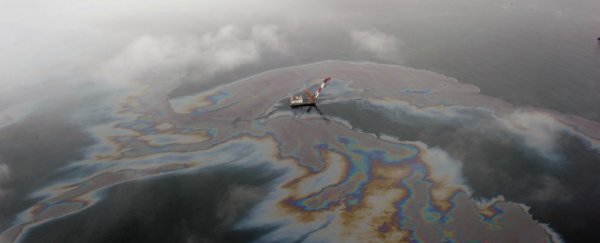In 2010, the Gulf of Mexico was hit by one of the worst oil spills in history when BP's Deepwater Horizon oil rig exploded, killing 11 people and dumping an estimated 3.19 million barrels of oil into the surrounding ocean. Though news of the spill has certainly calmed down over the past six years, researchers are still discovering just how disastrous the event was, especially for baby dolphins.
The sad truth is that, as long as we pump oil out of the oceans or transport it via ships, a spill is always possible. But the good news is that Australian researchers might have found a better way of cleaning them up before they destroy an entire ecosystem: a new fabric covered in nanostructures that attract oil and repel water. In other words, a mop for the ocean.
According to a team from Queensland University of Technology, the new material is covered in a layer of tiny nanostructures that look like rods. These ultra-small, semi-conducting rods on the fabric's surface allow water to run through them while trapping oils and pollutants.
If that all sounds awfully simple, it's because it is. According to the researchers, even the process used to make the fabric is a simple one, as materials chemistry researcher, Anthony O'Mullane, explains:
"We took commercially available nylon that already had a seed layer of silver woven into it which makes it easier to carry out the next part of the process - addition of the copper. We then dipped this fabric into a vat where a copper layer was electrochemically deposited onto it.
Now with a copper coating, we converted the fabric into a semiconducting material with the addition of another solution that causes nanostructures to grow on the fabric's surface - the key to its enhanced properties."
Thanks to the copper used in its manufacture, the fabric has antibacterial properties as well as decontamination properties, making it the perfect device for cleaning water supplies in remote villages along with the oceans. And since it's semi-conducting, it can degrade organic pollutants using visible light.
All in all, the new fabric has everything going for it so far.
The fabric is now undergoing tests to ensure that the rods can hold up after continued use. The next step is for the team to scale up the fabric to make it viable for large, Deepwater Horizon-scale spills. They haven't given a timeframe for this stage of testing, but hopefully it'll be ready for when the world needs it.
The team's full report has been published in ChemPlusChem.
QUT is a sponsor of ScienceAlert. Find out more about its research.
